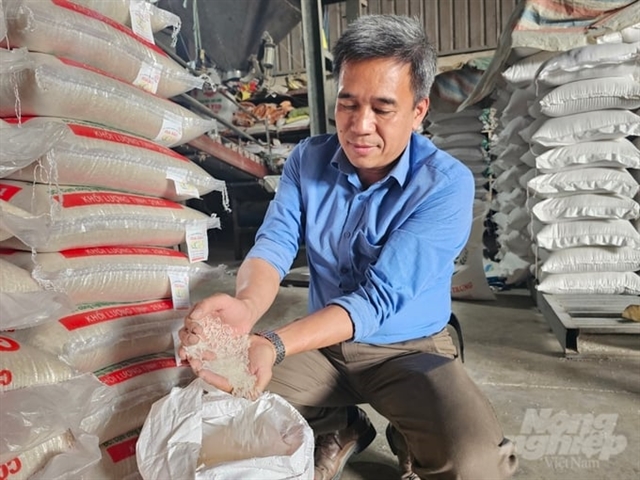 Society
Society


|
| A large-scale rice field in Thanh Hóa Province. — Photos nongnghiep.vn |
THANH HÓA — Nguyễn Duy Thỏa is very pleased when locals give him the nickname 'the daring one'.
While some people have abandoned rice cultivation, Thỏa in Trường Sơn Commune, Nông Cống District, Thanh Hóa Province, enthusiastically rents land to grow rice.
"What is difficult, what others won't do, I will do," Thỏa told Nông Nghiệp Việt Nam (Việt Nam Agriculture) newspaper.
After many nights of contemplation, he decided to lease the fields of local villagers to establish large-scale rice fields.
He and the local authorities spent years persuading residents to lease him land, and finally he gained the use of 5.4ha of land.
He doesn't remember how much money and effort he poured into this project, including land levelling, embankment, soil improvement and irrigation.
He lost weight while tirelessly pursuing the work for this project.
Thỏa has never dared to wear a white-collar shirt because he is busy all day in the paddy fields. His fields are the largest in Trường Sơn Commune, so it takes a lot of effort to manage.
Last year, he harvested about 1,500 tonnes of rice.
This year, he plans to expand the cultivation area when rice prices are favourable.
The cultivation of rice is now not as hard, with the help of machinery and hired labour.
"People can't do it without machinery. Instead of working hard all day, the machine can finish the job in just a few minutes," Thỏa said.
Seeing his success at farming, local people continue to rent the fields to him.
Unable to handle all the work alone, he came up with the idea of signing production contracts with households, purchasing rice seedlings from locals and from outside the province.
"Local people all have experience in farming, but what's crucial is to have someone organise the production. In the past, most households worked individually, relying simply on their personal strength,” Thỏa said.
"The farmers have to invest a lot of effort but do not achieve high profits when prices fluctuate unpredictably. With a large paddy field, I opt for a comprehensive lease, covering everything from planting to harvesting. In this way, the costs are significantly reduced compared to individual household cultivation.”
At present, he takes on the responsibility of marketing for the locals, along with managing the supply of agricultural inputs and renting machinery for sowing and harvesting several hundred hectares of fields within and outside the province.
This helps ease the burden of labour for locals and provides them with peace of mind.
"The farmers also don't have to worry about selling rice because the rice is contracted by four businesses in the North, ensuring a relatively stable price," said Thỏa.
Big idea
Leveraging the superior quality of Vietnamese rice, on par with or even surpassing that of countries with similar conditions and cultivation methods, Nguyễn Văn Tấn, a former mechanical engineering student from Hà Nội University of Science and Technology, made a remarkable decision.
He gave up his career prospects to return to agriculture.

|
| Nguyễn Văn Tấn with sacks of rice. |
In Tấn's view, if rice production remains fragmented and small-scale, the products will stop at self-sufficiency, never developing market exposure or a recognisable brand.
Realising this, he invested in a rice processing factory in 2018, located in the Tây Bắc Ga Industrial zone, Valued at VNĐ4 billion (US$162,000).
"Rice without a brand poses a significant risk due to market fluctuations. However, if rice products establish both quality and a reputable brand, market dynamics become both a challenge and an opportunity, especially for branded products with region-specific codes, meeting stringent food safety conditions and offering clear origin traceability," Tấn said.
The businessman received attention and support from provincial leaders, the agriculture sector, and local authorities.
He engaged in planning a safe and high-quality cultivation area, aiming to establish cultivation area codes, create a large raw material zone for the processing plant, and focus on exports.
"Providing raw products alone is not sufficient. At least, rice must have a brand and clear origin that consumers can trust. When Vietnamese rice has a brand name and a stable market, there is no worry about price fluctuation due to bumper crops."
After years of hard work and efforts, Tấn has expanded the raw material area in Triệu Sơn, Nông Cống and Hậu Lộc districts, Thanh Hóa City.
As the business owner, he provides fertiliser, seeds and technical support for cultivation, harvesting and market access to local farmers through cooperatives and large-scale agricultural producers. In 2022, the company was granted a cultivation area code for the concentrated cultivation area of ST25 rice variety and glutinous rice in Thiệu Dương and Thiệu Vân communes, covering an area of 70ha.
"The issuance of cultivation area codes is crucial to ensuring the safety, quality and export orientation of products. The cultivation area code is an important condition for creating sustainable value in agriculture in general, and for the rice brand in particular."
Currently, Tấn sells about 3,000-4,000 tonnes of rice annually, with revenue of around VNĐ40-50 billion.
His products are consumed mainly in the northern market.
"The value chain linkage in agricultural production plays a crucial role in strengthening links between farmers, State, businesses, banks, scientists and distributors. When participating in production linkage, farmers have a more proactive approach to the market, changing their perspectives on production, business and collaboration," said Cao Văn Cường, director of the provincial Department of Agriculture and Rural Development.
"This allows them to effectively utilise land resources, labour, production experience, business expertise and their strengths. The government supports them with training in production techniques and business plans." — VNS




